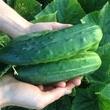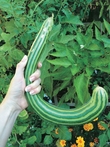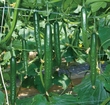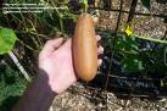Owing to the screen size of your device, you may obtain a better viewing experience by
rotating your device a quarter-turn (to get the so-called "panorama" screen view).
|
This page updated for 2022.
|
Click here for the site directory.
|
|
Please consider linking to this site!
|
Click here to email us.
|
Cucumbers
(Cucumis sp.)
Cultivars

Nero Wolfe, the great 286-pound gourmet (and detective), in a fit of anger swears an oath that he will eat no meat until the current case is resolved. Archie Goodwin, his All-American and sardonic associate, is unimpressed, and vows in response that in that case he will eat no boiled cucumbers until the case is over.
The cucumber assuredly has its partisans. We do not by any means dislike it, we just don’t think it a really important vegetable. It is, we feel, at its very best when served quite cold on a hot day, dressed with yogurt and a heavy dusting of dill weed (a classic dish)—or when made into the soup-like Greek concoction called tzatziki, which is just the same cucumber/yogurt/dillweed combination, but whizzed in a blender. As Wakko Warner would say, “Deeeeeelicious!”
And, as with all our warm-weather crops in this region, we need early types, though most common ones are reasonably early. But before even getting to particular cultivars, it helps to know that a “cucumber” can be any of several different species, and even different genera (cucumbers and melons are quite closely related, and at least one “cucumber” type, the “Armenian”, is really, in biological terms, a form of melon). The common type is often divided in seedsmen’s catalogues into “slicers” and “picklers”, but there isn’t much real differentiation there other than traditional uses and perhaps size.
In gardening and culinary terms, not taxonomic ones, the usual and unusual sorts of available cucumbers are described below. While individual tastes can vary—is mildness of cucumber flavor a plus or a minus?—most sources do incline to perceiving the Armenian, Oriental, and Beit Alpha types as better-eating varieties than the familiar common types, as to actual flavor and also as to bitterness and gas production (“the burps”). Also noteworthy is that at bottom it seems most tasters put a higher premium on a lack of bitterness than on taste as such, which may be why the non-standard types tend to be higher-ranked. In the list below, we have shown what our investigations have suggested as choices. If we had to pick just one type, it’d be that rather unusual Indian cultivar the Poona Kheera, which looks more like a potato rather than a cucumber, but gets rave reviews on taste and productivity, and is also particularly early.
Common Cucumber


(The common cucumber is often also called the “Dutch” or the “English” cucumber.) The usual choice for this type is the classic Marketmore 76—that’s it at the right (beware: there are other Marketmore types with different numbers, but the 76 is the wanted one). Another possibility is the type Chicago; it is described as a “pickling cucumber”, which just means the cukes are a bit shorter and fatter than so-called “slicing cucumbers”. (That’s it at the left.)
Armenian

The Armenian is a long, often much curved type (as noted, actually not a true cucumber but a type of melon); owing to its shape, it is sometimes referred to as the “serpent” or “snake” cucumber. It is hard to recommend a particular cultivar, as few catalogues distinguish one “Armenian” type from another. Though many find the taste of Armenian cukes superior to that of common cukes, some don’t like their texture. Also, Armenians must be picked fairly young, else they often turn into a sort of giant generic “banana melon”. They’re usually at their best at 12" - 15" long, but can grow to 30" or even 36". As melons, they need more heat to grow well than do true cucumbers. A recommended type is the Painted Serpent (c. 80 to 90 days from seeding).
Oriental

This type is also commonly called “Japanese”, though many Oriental nations grow the type (it is also often called “Asian”). It is another long type, usually thin and straight, with a milder flavor than standard types. The Oriental types have many partisans, who find them tender and better-tasting than common cukes (and less bitter and gas-producing), but otherwise generally similar. A notably good representative of this type is the type Japanese Long (65 to 75 days).
Beit Alpha

The “Beit Alpha” type (sometimes called “Persian”) is an Israeli development (they have developed a lot of useful hot-weather crops, notably melons and lettuces) whose plants are largely or wholly female and so do not need cross-pollination. They are reported to have an excellent taste and low bitterness. All cultivars of this type reportedly taste about the same. Note that owing to its origins, most beit alpha types are hybrids, but there are some open-pollinated cultivars available; those are rarely named—an exception being the “Super Zagross” type (c. 55 days). With most seedsmen, you’re lucky if they even say whether their Beit Alpha offering is hybrid or OP.
Kiva


This may be the most exciting category of them all, owing to the fairly recent focus on these reportedly excellent-tasting types, most or all from India. One that is no longer a rare novelty is the much-praised, almost funny-looking Poona Kheera (55 days, many report much less), which resembles nothing so much as a potato (see image at left); it is emerging as possibly the best-tasting cucumber of all cucumbers in many opinions—though a couple of other similar types, recently appreciated by the marketplace, the Sikkim (60 to 80 days; image at right) and the Kaiser Alexander, are close competition. (The Sikkim is now also—like the Poona Kheera—widely available, the Kaiser Alexander less so.)
Some Selecting
Individual tastes may vary, but we see so many, many sources saying that they’ll never again eat ordinary cukes after having sampled one or another of the other kinds that we, at least, will not be growing any ordinary garden types again. We also are not crazy about very thin cucumbers, and so will leave out the Asian types (but that’s just a matter pf personal taste). That said, we will try the Armenian type Painted Serpent, an OP Beit Alpha type, and two Kiva types, Poona Kheera (which we have already grown with success) and Sikkim. We expect that after this season we will narrow down to one or two types, depending on what does best for us. But we think all four types worthy of your consideration. There: wasn’t that easy?
Planting
Timing
You certainly can do these as seedlings to transplant, but our summers, though short, are quite warm, so we’re going to go with direct seeding (which seems common for cukes). The DTM (days to maturity) for our selected cukes vary from as little as 30 days (reported for Poona Kheera) to perhaps as much as 90 days for Painted Serpent.
Cucumbers like it warm: they supposedly grow best at temperatures over 80°F., which in our climate start around June 21st on average. To be more exact, we will seed all four types on June 22nd, and see what happens. But whatever your timing, plant cucumbers out only long after the last expected frost—cucumbers cannot take frost—and look for that 80°F. air temperature. You can, and should, pre-warm the soil with plastic mulch starting at least two weeks before seeding.
Sowing Seed
Plant seed ½ to ¾ inch deep. In a deep-dug bed, space plants about one foot apart. Remember that most of these are climbers, so you will likely need to provide a suitable trellis for them to grow on.
The Bed
Cucumbers are not terribly fussy about soil type (though sandy loam is better) or pH (though some say that keeping the pH very low-acid, say 6.8 to 7.0, helps prevent that bane, the bitter cuke); but they do need really rich soil, so fertilize heavily.
Also, cucumbers require a lot of water, constantly available; on the other hand, they do not like “wet feet” and can damp off. Moreover, they have deep roots—three to four feet—best encouraged by “deep watering”. All that put together means that cucumbers require really well-drained, really deeply spaded soil.
Their spot in the garden has to be a sunny one.
Some sources recommend avoiding use of the same ground for cucurbits (cukes, melons, squash) more often than once every two or even three years, owing to possible soil-borne diseases. Our advice, given elsewhere on this site, is a four-year, four-bed-types (Brassicas, Solanaceae, corn, and “miscellaneous”—or a five-year plan if you have a potato bed) rotation plan, to avoid just such problems (Brassicas are the highest disease risk).
Cucumbers, like a surprisingly great number of home-garden vegetable plants (including some said to have deep roots), do quite well in containers. Even if you have a lot of space, containers are helpful in managing pest problems (mainly rodents, like voles), because you can easily put a low metal-mesh screen (¼" openings) around the the inside edge of the container. If you are considering containers, five-gallon containers are said to allow growing “one or two” cucumber plants.
The use of plastic mulch—set out a week or two before the expected transplant date—to get and keep the soil warm is a good idea for these heat-loving plants. (See our site page on colored plastic mulches for more information on that topic.)
Growing
Cucumbers, as noted, require a lot of water, constantly available—they do not like irregular watering—but need to be encouraged to send down deep roots. If you have prepared the soil well, as described above, give them a really heavy soaking every few days—one source says once a week—but take care that the soil around them stays moist for a good ways down (a good soil-moisture meter is, like a good soil-temperature gauge, an invaluable tool). And don’t overhead water: run soaker hoses or use a drip system.
Keep cucumbers as weed-free as possible, but take care: do not hoe deeper than at most an inch or you will likely cut some feeder roots.
When the vines are about 10 to 12 inches long, side-dressing with some extra fertilizer can be a help, but don’t go crazy, lest the plants grow more vine than fruit.
All cucurbits develop separate male and female flowers. Male flowers develop first, and are easily distinguished as a plain flower on a long stem, having only stamens; female flowers form large ovaries, which look like small fruit. After the first female flowers are pollinated, the vines develop both male and female flowers.
(Some melons, many squashes, and all cucumbers cross-pollinate with one another. If you plan to save seed, grow only one variety of each type. To ensure vigorous seed, you should hand-pollinate by removing a male flower from one plant then shaking it inside a female flower on another plant; to prevent further pollination of that second plant, close the female bloom with a piece of string or twist-tie for a few days.)
One expert source recommends that when the plants achieve six or seven true leaves—not seed leaves—you pinch off the growing points, so as to make the plants branch and straggle. But do not remove the flowers.
If any growing cukes are in contact with the ground, put something—glass, plastic, tile, whatever—under them to keep them out of contact with the soil.
Healthy cucumber plants grow relatively rapidly. When once the plants start bearing, pick daily when the cukes reach a decent size (but most of the types we recommend can get safely pretty long); whatever you do, do not wait till your cukes turn yellow—yellow cucumbers are overmature and will be strong flavored and of poor quality (but note that the Poona Kheera cuke is naturally brown, so that’s not a sign of danger for it). Harvest by cutting the stem about ¼ inch above the fruit. Most sources suggest that well-picked healthy plants will continue to produce till the weather cools (and stop at the first frost).
Although it seems counter-intuitive (because cukes are something like 95% water), cucumber can be frozen. Different sources suggest somewhat differing ways; here are numerous ways to freeze cucumbers. (We didn’t read them all, just the first few, but if you are chiefly interested in tzatziki, you could probably just freeze blender- or food-processor-made cucumber puree.)
More
Relevant Links
Besides any links presented above on this page, the following ought to be especially helpful:
Odds and Ends
Biology
Cucumbers are of the Cucurbitae family, and are very closely related to melons (the “Armenian cucumber” is really as much a melon as a cucumber); other well-known members of the family are squash and pumpkins. Cucumber flowers are monoecious (individual flowers are either male or female, but both sexes can be found on the same plant) and are pollinated by insects; the plant is thus self-fertile.
History
We try not to re-invent the wheel. Here’s a link to a good history of cucumbers [archived copy].
Envoi
Some say that cukes taste best eaten within a few hours of being picked, so plan on using lots of cucumber during their season; if you have no other ideas, recall that tzatziki (mentioned above) makes a mighty refreshing summer beverage, one that we, at least, never tire of.
We don’t usually do recipes, but here’s a super-easy tzatziki:
- Throw these into a blender:
- a large, peeled cucumber (seeded if you prefer)
- a quart of yogurt
- 2 tablespoons of a good olive oil (extra-virgin is best, and it’s not particularly expensive)
- a tablespoon of fresh dill (or whatever your favorite cookbook says is the equivalent dried, if you’re so unfortunate as to not have remembered to grow dill weed)
- a tablespoon of a good red-wine vinegar (there really are significant differences—try “Pompeian Gourmet Organic Red Wine Vinegar”, for instance)
- at least two cloves of garlic (peeled if you’re a wimp), though three or more is better
- Whizz it up really well.
- Refrigerate it for at least an hour—it needs to be well-chilled.
- Drink it, then make some more. There—wasn’t that easy?
And, in our classic Envoi form, here’s a link to the very first edition of the e-zine Cucumber Focus.
Return to the top of this page.
If you find this site interesting or useful, please link to it on your site by cutting and pasting this HTML:
The <a href="https://growingtaste.com/"><b>Growing Taste</b></a> Vegetable-Gardening Site
—Site Directory—
Search this site, or the web
-
Background Information
about the purposes and design of this site
- Site Front Page
-
Introduction

- An Apologia: why one should cultivate one's garden
- Deep-Bed Gardening (forthcoming)
- Container Gardening (forthcoming)
- Vegetarian and Organic Considerations (forthcoming)
-
Recommended Crops for a home garden, by variety
-
Gardening information and aids
-
Miscellaneous Information of interest to the home gardener
Since you're growing your own vegetables and fruits, shouldn't you be cooking them in the best way possible?
Visit The Induction Site to find out what that best way is!
|
If you like good-tasting food, perhaps you are interested in good-tasting wines as well?
Visit That Useful Wine Site for advice and recommendations for both novices and experts.
|

|
This site is one of The Owlcroft Company family of web sites. Please click on the link (or the owl)
to see a menu of our other diverse user-friendly, helpful sites.
|
|
 Like all our sites, this one is hosted at the highly regarded Pair Networks,
whom we strongly recommend. We invite you to click on the Pair link for more information on getting your site or sites hosted on a first-class service.
Like all our sites, this one is hosted at the highly regarded Pair Networks,
whom we strongly recommend. We invite you to click on the Pair link for more information on getting your site or sites hosted on a first-class service.
|
|
All Owlcroft systems run on Ubuntu Linux and we heartily recommend it to everyone—click on the link for more information.
|
Click here to send us email.
Because we believe in inter-operability, we have taken the trouble to assure that
this web page is 100% compliant with the World Wide Web Consortium's
XHTML Protocol v1.0 (Transitional).
You can click on the logo below to test this page!
You loaded this page on
Friday, 18 April 2025, at 21:50 EDT.
It was last modified on Friday, 3 June 2022, at 20:30 EDT.
All content copyright ©1999 - 2025 by
The Owlcroft Company








